There is an air of excitement about town. A funeral is happening and we have been invited.
For the Torajans, the most important thing about life is death. Some of the most unique and complex burial rituals in the world are practiced here and I have to confess we are very curious about these famously elaborate ceremonies.
Ritha, a local Torajan tells us the funeral season is looked forward to by the whole community, a time to celebrate ‘The Way of The Ancestors”. As we set off for the day, Ritha keeps us enthralled about the traditions and beliefs of the Torajan people and we begin to understand that there is nothing morbid about death here.
“Our” funeral
It is odd to think that we are actually delighted to be invited to a funeral. My parents ask if we knew the deceased and the answer is no. The dead person, for whom we must purchase 200 cigarettes, died 4 years ago, aged 58. The funeral will last 5 days.
Living with the dead
As we drive though the countryside and villages of Toraja Land, many homes have what looks like a hastily made surrender flag white piece of cloth on a stick staked nearby. This is a sign that a deceased person is being kept in the home. Dead people seem to be everywhere! At least every 5 or so houses. The dead may not be breathing, but they are not referred to as dead until the funeral has taken place. Until then, they are “just sick”.
Meals are delivered to the body at mealtimes, they are talked to, washed and given a change of clothes. If the person was of importance within the village they may still be referred to for important decisions. The bodies are treated with chemicals so they don’t bloat or smell and don’t decompose. Many lie on their bed, the alternative is an open coffin in the main living area of the home, where they stay for weeks or months. Gradually they do mummify, for there is no time limit on how long the dead may live with the living. Five or more years not uncommon….It takes a long time to arrange a funeral!
Preparing for the funeral
“We live to die”, Ritha emphasizes again. “Nothing is more important than a good funeral”. Funerals are held June to October, and must be held in the originating ancestral village, regardless of where life was lived.
There will typically be hundreds of guests, perhaps 1000+, and many special bamboo structures need to be built for them. These hand built buildings are “one time use only” and surround the arena-like space where events will be held. Several coffins will also be hand made, as is a coffin cart, which will be hand painted and used only once. All extended members of the family must attend, which takes some organizing as many have distant relatives overseas. Relatives may also need time to save up in order to contribute financially if the deceased did not accrue enough during their own lifetime.
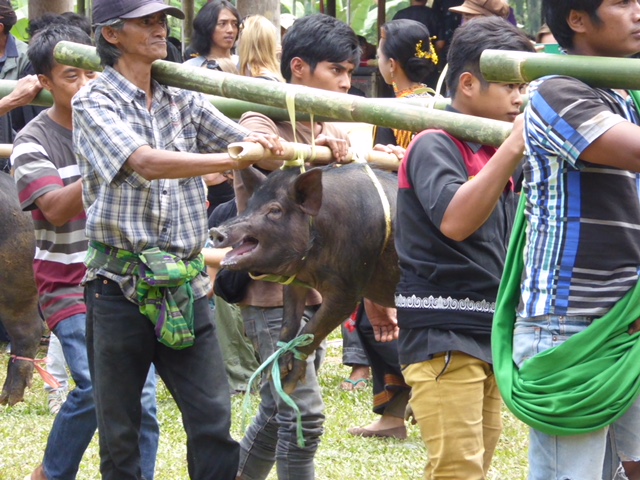
The Cost
The culture throughout life is saving for death. Funerals are colossally expensive. Buffalos are a necessity for a funeral as these are sacrificed for the deceased soul and many are required. Buffalos are considered currency, a show of wealth, and are both highly prized and highly pampered. Prices start at around US$500 to buy in the market. A particularly good specimen could cost twice as much and an albino so much more again around $1,500-2,000. A tax is also levied on each sacrificial buffalo.
Ritha, still in her twenties, tells me she has been saving for her funeral since she started working. Her family have purchased a buffalo and rent land to look after it, in readiness for whichever family member needs it first.
Most families in the region are subsistence farmers and a single buffalo represents a massive investment, so it is understandable the reverence with which buffalos are treated. To have many buffalo is to be wealthy.
Sacrificial Buffalos
A funeral typically lasts several days, starting and finishing with buffalo slaughter. The ritual is rich with meaning. The belief is that first buffalo will release the spirit of both the deceased and the buffalo which will then carry the deceased on the pathway to the ancestors in the after-life.
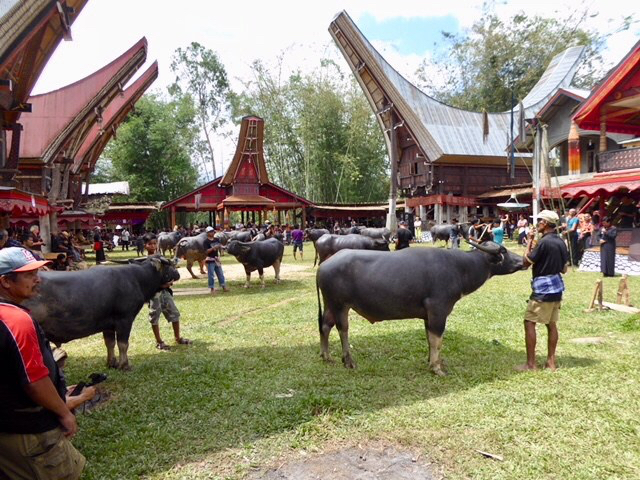
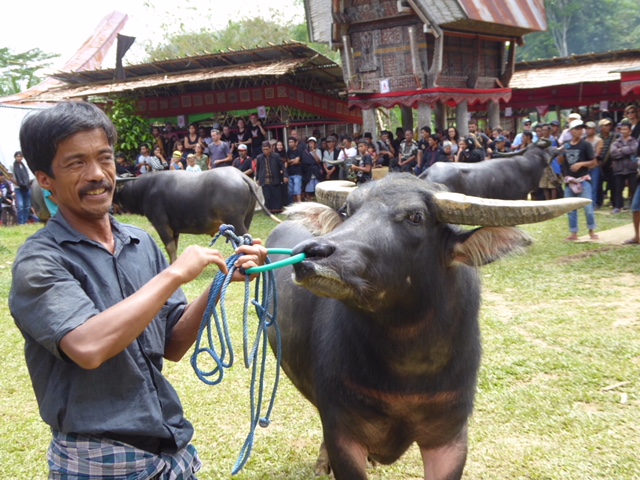
The slaughter was not fast, nor it seemed, painless and several attempts were made at slashing the throat of the tethered beast as it bucked.
Ritha says they will use a sharper knife on the others.
The remaining 19 buffalo will be slaughtered on the final day of the funeral. This ritual provides food for the spirit journey and wealth in the after-life, and for the living, a sort of food distribution system. The family of the deceased will decide how the meat will be divided among local families and community members. I think this is really good….but I am glad we will not be here to see the mass slaughtering, despite being meat-eaters!
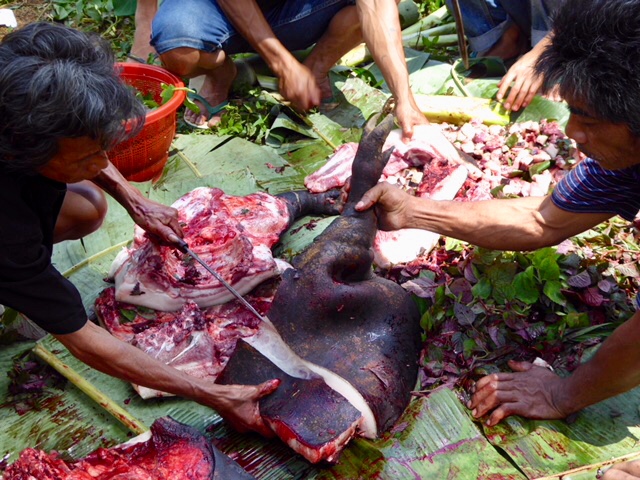
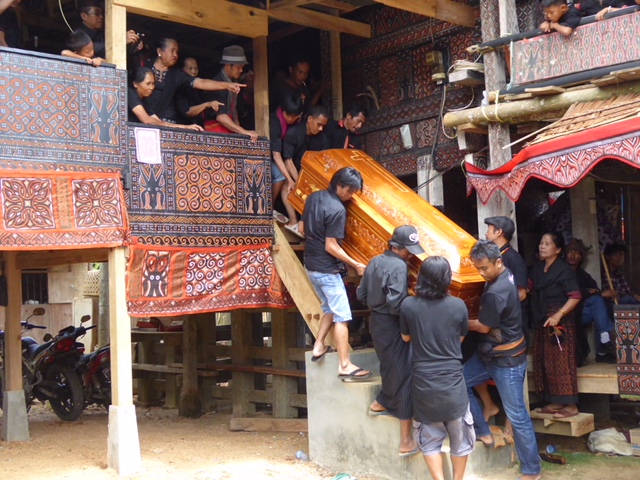
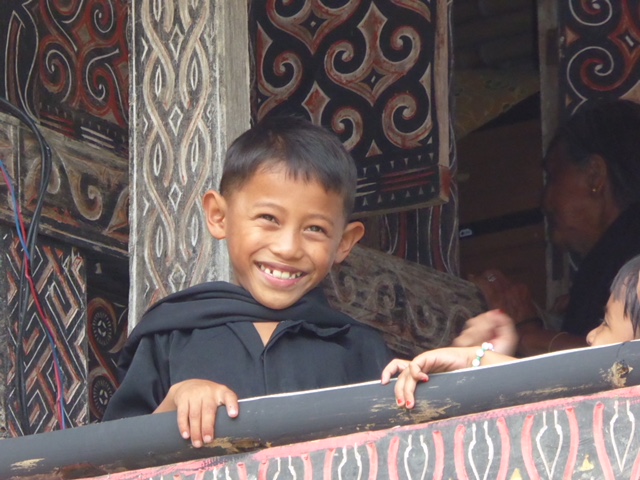

Somewhat surprisingly, part way through the events today passages from the Bible were read aloud. The Toraja religion is Aluk To Dolo (Way of the Ancestors). However 90% of people here also follow Christianity, as does this family.
The following slideshow shows a bit more of this very interesting day. (Double click to enlarge to be able to read the captions.)
Death does not mean Goodbye
The dead are not to be forgotten and the funeral is far from a final goodbye as regular exhumations bring the corpses back into family life.
A festival called ma’nene sees the family return to the ancestral tombs to “tidy up” and introduce new family members to their ancestors. The long dead bodies are taken out of their tombs and dressed in new clothes before being paraded around the village.

The “healthier” looking the corpse is, the belief is that better luck will be bestowed on their children and grandchildren. It’s not just the recently departed that are paraded like around the village either. All ancestors are part of the family and so it is completely normal to have family photos to include both the living and dead. I am told this ritual gives a sense of fulfiment for the living relatives to be able to connect with their ancestors of generations gone by.

The ma’nene festival happens every three years August, right in the middle of the funeral season. The family wear bright clothes for the celebrations and the new clothes for the deceased are in today’s fashions. When the bodies are returned back to their resting place, they go with gifts of food, drink and a plentiful supply of cigarettes.
Footnotes : Tourists are welcomed at Torajan funerals, as it is seen as a privilege to host a foreign visitor. However, guidelines must be followed to avoid offending. As all guests must be offered drinks and snacks, it is expected that a gift be given to the deceased family. Typical expectations from a tourist are 200 cigarettes or 5 litres of palm wine (much easier than a pig, as a local family would be expected to bring! ). The guests should wear dark colours. The biggest faux paux of all is to sit or stand in, or even in front of, any of the bamboo shelters which each are built for specific guests. You may be invited to a bamboo area, but otherwise, keep very mindful of blocking the view for any of the local people.
There is so much more to Torajan burial ceremonies, that I may have to write another post. Watch this space.
Photos of the ma’nene corpses are courtesy of Brian Lehmann.

Fascinating, fantastic description of the funeral! That first photo of Debora Maupa, who died in 2009, is remarkable and eerie. Amazing to live with death as such a natural experience.
Glad you enjoyed paulesue. The Torajans certainly have a unique approach to life and death!